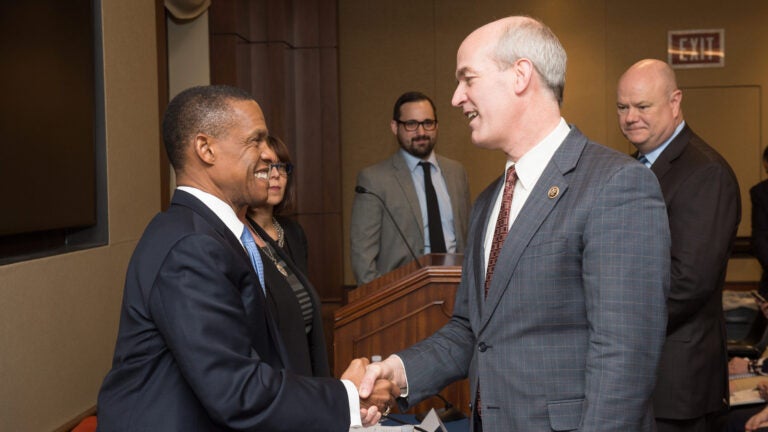
Erroll Southers with Rep. Rick Larsen, who serves on the House Transportation and Infrastructure Committee. (Photo/Dave Scavone)
Congressional School Safety Caucus helps districts assess their needs
USC security expert Erroll Southers offers his expertise on Capitol Hill
Erroll Southers, director of homegrown violent extremism studies at the USC Price School of Public Policy’s Safe Communities Institute, took to Capitol Hill to participate in the first event of the newly formed Congressional School Safety Caucus.
Southers provided his security expertise at a panel discussion on “Challenges and Opportunities to Protect and Ensure Safety for America’s Schools.”
“I was honored to be asked to participate in the inaugural assembling of the School Safety Caucus,” Southers said. “We all agreed we do not want to convene after the next school tragedy with nothing accomplished. It’s time to take action to protect America’s most valuable asset — its students.”
Creating safe environments
Reps. Rick Larsen (D-Wash.) and Susan Brooks (R-Ind.) launched the caucus on March 2 to address the challenges, best practices and investments needed to help schools meet their unique safety needs. Larsen also introduced the School Safety Act, which would revive federal assistance to help schools implement security measures. Brooks is a co-sponsor of the bill.
I want to see Congress do more in supporting our schools and communities to shrink the cycle of violence.
Rick Larsen
“Schools must be a place where our students feel safe,” Larsen said. “The School Safety Caucus is a forum to look at the best ways for schools to approach their safety needs, as well as to push for investments in security and other safety measures. I want to see Congress do more in supporting our schools and communities to shrink the cycle of violence.”
Larson cited statistics showing that instances of violence at schools and university campuses are occurring at an alarming rate. Of high school students in the United States, 7 percent responded that they were threatened with a weapon on school property in the past year, more than 5 percent brought a weapon to school in the past month and 7 percent skipped school because they felt unsafe.
The issue corresponds with Southers’ research on homegrown violent extremism, where he finds that teenagers and young adults are most susceptible to being influenced by extremist ideology.
“I’m disappointed that I have to be here as a counterterrorism expert because I’m hearing that violent extremists view schools as a soft target,” Southers said. “Schools have individuals who feel alienated, who may have adopted a legitimizing ideology and because of some enabling environment they feel like they have the capacity to act, and they will.”
Assessing school security
Southers advised that every school in the nation needs an independent vulnerability assessment conducted because there is no one-size-fits-all implementation of countermeasures. Each school has a different culture and environment. Even schools in the same district are demonstrably different when it comes to threat level. Once an assessment has been completed, he suggests creating a 12-month, three-year and five-year plan to address a school’s security needs.
“The relationships with your school, your students, your faculty and your community are really what are going to make it safe,” Southers said. “To educate to that level of preparedness is what sets the stage for a school to reduce risk — and it’s all about reducing risk. These adversaries and assailants pick their targets, and it’s not by accident. You want to set the school up to offer a presence that deters them from doing something.”
